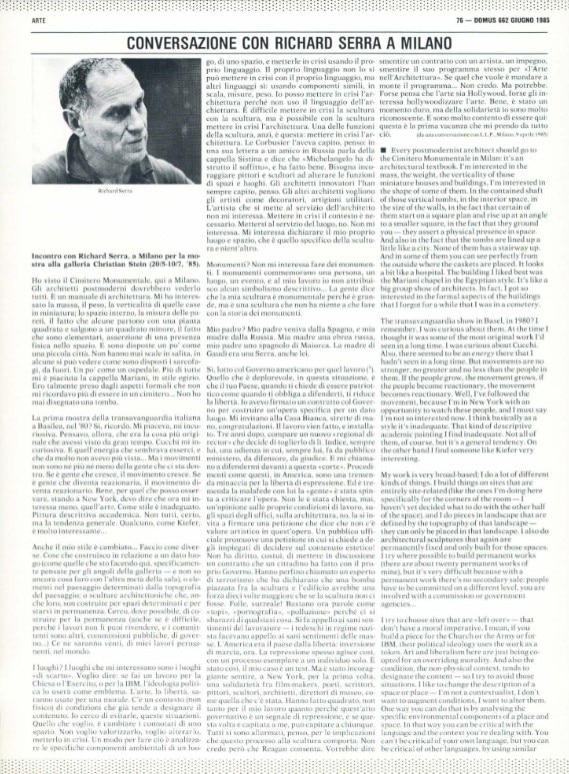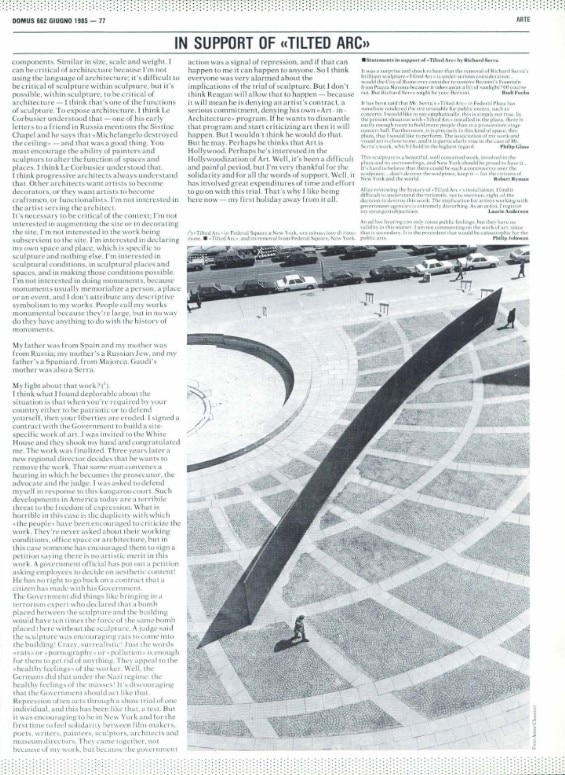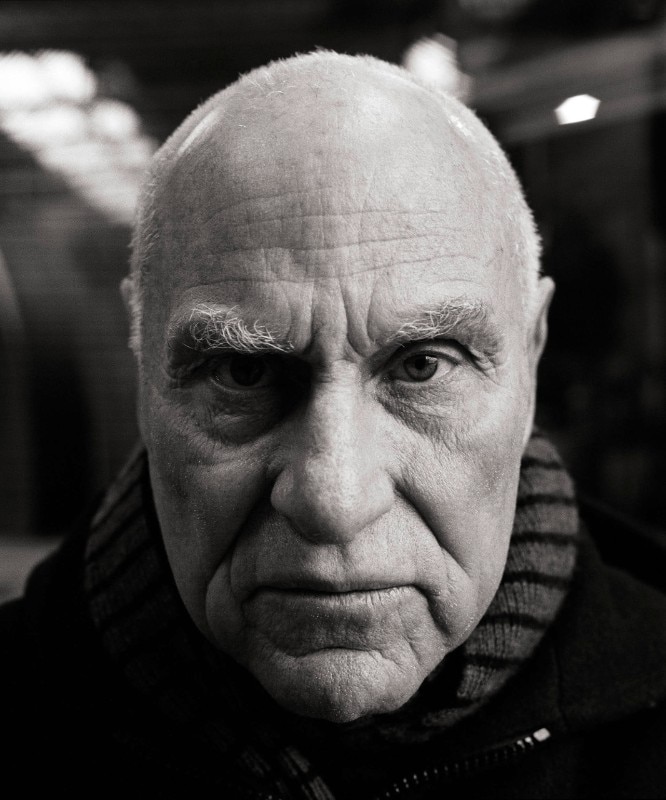His name is now almost instinctively associated with images of great coils of metal stretching and and recoiling across natural, urban landscapes or vast exhibition spaces: the path of Richard Serra through art, however, was much deeper and more complex, it corresponded to a crucial season in American and international art. The San Francisco-born artist, who died March 26 aged 85, had merged his research with the trajectories of minimal art that animated the New York scene of the 1960s, debuting in his thirties in a milestone group show at the Guggenheim in 1969, only later to approach the expressions of land art that made him world famous.
In June 1985, in Milan, a conversation with Lisa Licitra Ponti recounted all this complexity, of an artist simultaneously participatory and critical of his time: collected and published on Domus 622, almost in the form of a stream of consciousness, this apparent monologue, actually a dialogue, deconstructed a set of mainstream assumptions such as Serra's supposed connection to monumentality, the possibility of fitting him into some category, and the reasons for the controversial reception of his first major public work, the 1981 Tilted Arc in New York, a gesture of political significance that was instrumentally reduced to polemics on aesthetics.

In support of Tilted Arc
Every postmodernist architect should go to the Cimitero Monumentale in Milan: it’s an architectural textbook. I’m interested in the mass, the weight, the verticality of those miniature houses and buildings, I’m interested in the shape of some of them. In the contained shaft of those vertical tombs, in the interior space, in the size of the walls, in the fact that certain of them start on a square plan and rise up at an angle to a smaller square, in the fact that they ground you – they assert a physical presence in space. And also in the fact that the tombs are lined up a little like a city. None of them has a stairway up. And in some of them you can see perfectly from the outside where the caskets are placed. It looks a bit like a hospital. The building I liked best was the Mariani chapel in the Egyptian style. It’s like a big group show of architects. In fact, I got so interested in the formal aspects of the buildings that I forgot for a while that I was in a cemetery.
The transavanguardia show in Basel, in 1980? I remember. I was curious about them. At the time I thought it was some of the most original work I’d seen in a long time. I was curious about Cucchi. Also, there seemed to be an energy there that I hadn’t seen in a long time. But movements are no stronger, no greater and no less than the people in them. If the people grow, the movement grows, if the people become reactionary, the movement becomes reactionary. Well, I've followed the movement, because I’m in New York with an opportunity to watch these people, and I must say I’m not so interested now. I think basically as a style it’s inadequate. That kind of descriptive academic painting I find inadequate. Not all of them, of course, but it's a general tendency. On the other hand I find someone like Kiefer very interesting.
My work is very broad-based; I do a lot of different kinds of things. I build things on sites that are entirely site-related (like the ones I’m doing here specifically for the comers of the room – I haven’t yet decided what to do with the other half of the space), and I do pieces in landscape that are defined by the topography of that landscape – they can only be placed in that landscape. I also do architectural sculptures that again are permanently fixed and only built for those spaces. I try where possible to build permanent works (there are about twenty permanent works of mine), but it’s very difficult because with a permanent work there’s no secondary sale: people have to be committed on a different level, you are involved with a commission or government agencies...
Movements are no stronger, no greater and no less than the people in them. If the people grow, the movement grows, if the people become reactionary, the movement becomes reactionary
I try to choose sites that are “left over” – that don’t have a moral imperative. I mean, if you build a piece for the Church or the Army or for IBM, their political ideology uses the work as a token. Art and liberalism here are just being co-opted for an overriding morality. And also the condition, the non-physical context, tends to designate the content – so I try to avoid those situations. I like to change the description of a space or place – I’m not acontextualist, I don’t want to augment conditions, I want to alter them. One way you can do that is by analysing the specific environmental components of a place and space. In that way you can be critical with the language and the context you’re dealing with. You can’t be critical of your own language, but you can be critical of other languages, by using similar components. Similar in size, scale and weight. I can be critical of architecture because I’m not using the language of architecture; it's difficult to be critical of sculpture within sculpture, but it’s possible, within sculpture, to be critical of architecture – I think that's one of the functions of sculpture. To expose architecture. I think Le Corbusier understood that – one of his early letters to a friend in Russia mentions the Sistine Chapel and he says that “Michelangelo destroyed the ceiling” – and that was a good thing. You must encourage the ability of painters and sculptors to alter the function of spaces and places. I think Le Corbusier understood that. I think progressive architects always understand that. Other architects want artists to become decorators, or they want artists to become craftsmen, or functionalists. I’m not interested in the artist serving the architect. It’s necessary to be critical of the context; I’m not interested in augmenting the site or in decorating the site, I’m not interested in the work being subservient to the site. I'm interested in declaring my own space and place, which is specific to sculpture and nothing else. I’m interested in sculptural conditions, in sculptural places and spaces, and in making those conditions possible.
I’m not interested in doing monuments, because monuments usually memorialize a person, a place or an event, and I don’t attribute any descriptive symbolism to my works. People call my works monumental because they’re large, but in no way do they have anything to do with the history of monuments.

My father was from Spain and my mother was from Russia; my mother’s a Russian Jew, and my father’s a Spaniard, from Majorca. Gaudì’s mother was also a Serra.
My fight about that work? I think what I found deplorable about the situation is that when you’re required by your country either to be patriotic or to defend yourself, then your liberties are eroded. I signed a contract with the Government to build a site specific work of art. I was invited to the White House and they shook my hand and congratulated me. The work was finalized. Three years later a new regional director decides that he wants to remove the work. That same man convenes a hearing in which he becomes the prosecutor, the advocate and the judge. I was asked to defend myself in response to this kangaroo court. Such developments in America today are a terribile threat to the freedom of expression. What is horrible in this case is the duplicity with which «the people» have been encouraged to criticize the work. They're never asked about their working conditions, office space or architecture, but in this case someone has encouraged them to sign a petition saying there is no artistic merit in this work. A government official has put out a petition asking employees to decide on aesthetic content! He has no right to go back on a contract that a citizen has made with his Government. The Government did things like bringing in a terrorism expert who declared that a bomb placed between the sculpture and the building would have ten times the force of the same bomb placed there without the sculpture. A judge said the sculpture was encouraging rats to come into the building! Crazy, surrealistic! Just the words “rats” or “pornography” or “pollution” is enough for them to get rid of anything. They appeal to the “healthy feelings” of the worker. Well, the Germans did that under the Nazi regime: the healthy feelings of the masses! It’s discouraging that the Government should act like that. Repression often acts through a show trial of one individual, and this has been like that, a test.
People call my works monumental because they’re large, but in no way do they have anything to do with the history of monuments.
But it was encouraging to be in New York and for the first time to feel solidarity between film-makers, poets, writers, painters, sculptors, architects and museum directors. They came together, not because of my work, but because the government action was a signal of repression, and if that can happen to me it can happen to anyone. So I think everyone was very alarmed about the implications of the trial of sculpture. But I don’t think Reagan will allow that to happen – because it will mean he is denying an artist’s contract, a serious commitment, denying his own “Art – in Architecture” program. If he wants to dismantle that program and start criticizing art then it will happen. But I wouldn’t think he would do that. But he may. Perhaps he thinks that Art is Hollywood. Perhaps he’s interested in the Hollywoodization of Art. Well, it’s been a difficult and painful period, but I’m very thankful for the solidarity and for all the words of support. Well, it has involved great expenditures of time and effort to go on with this trial. That’s why I like being here now – my first holiday away from it all.
Opening image: Richard Serra, photo © Oliver Mark


